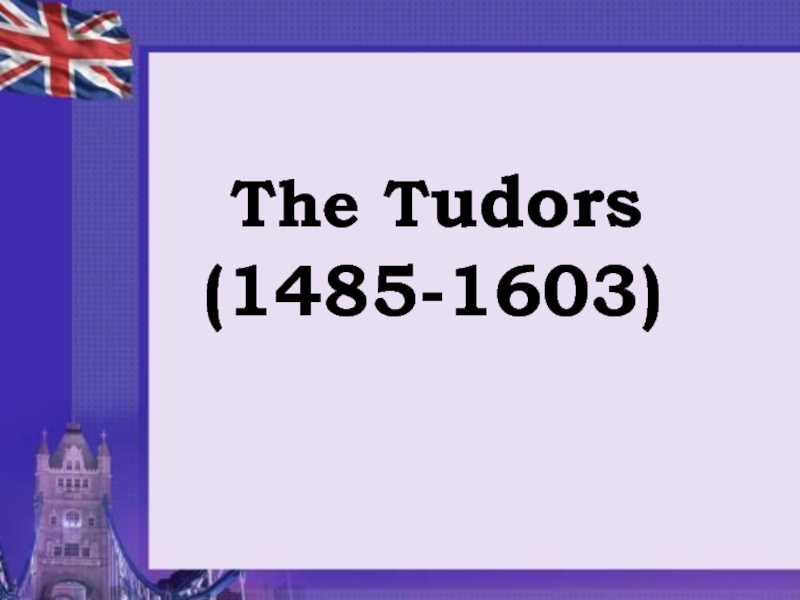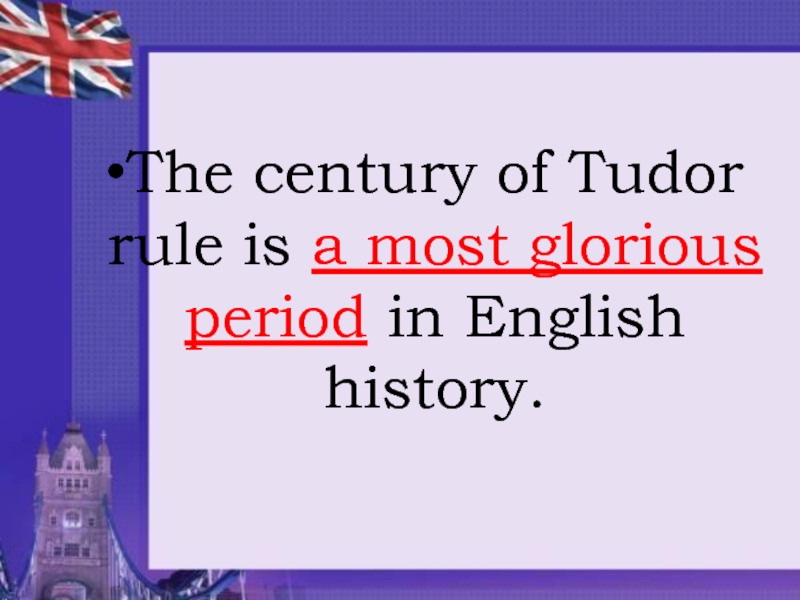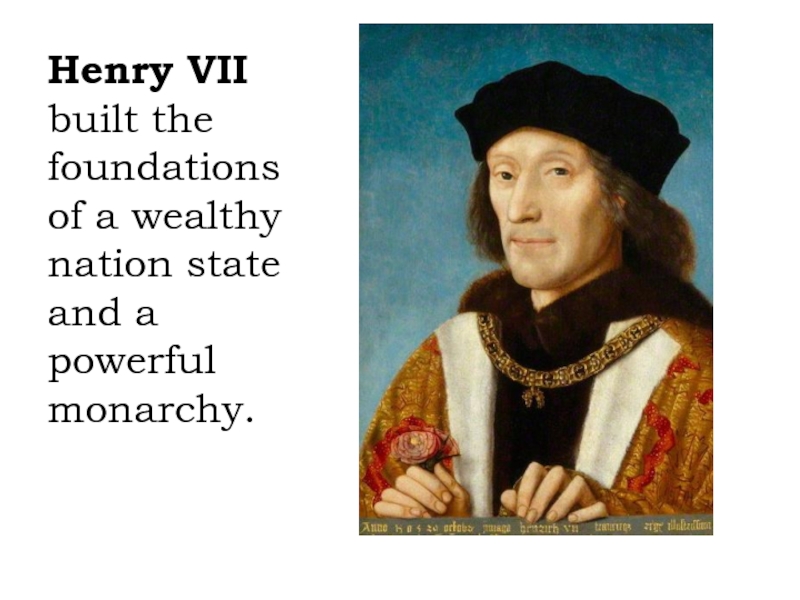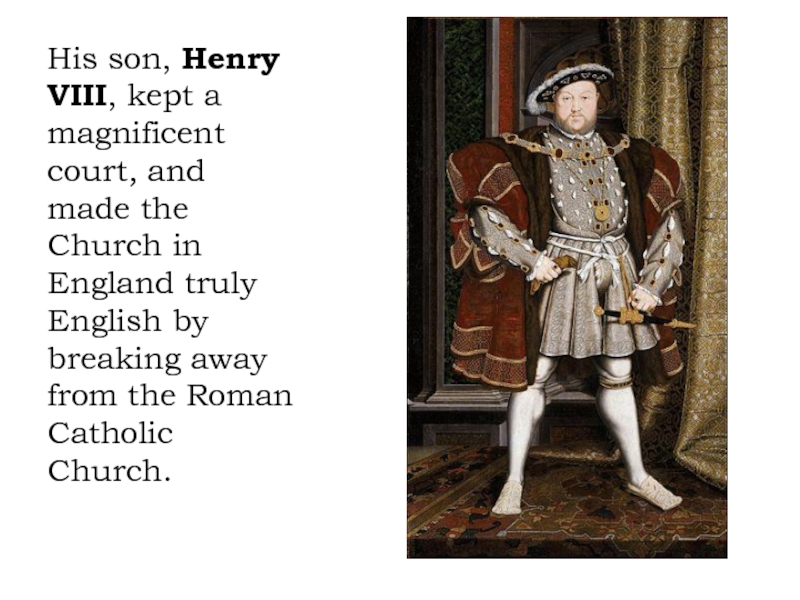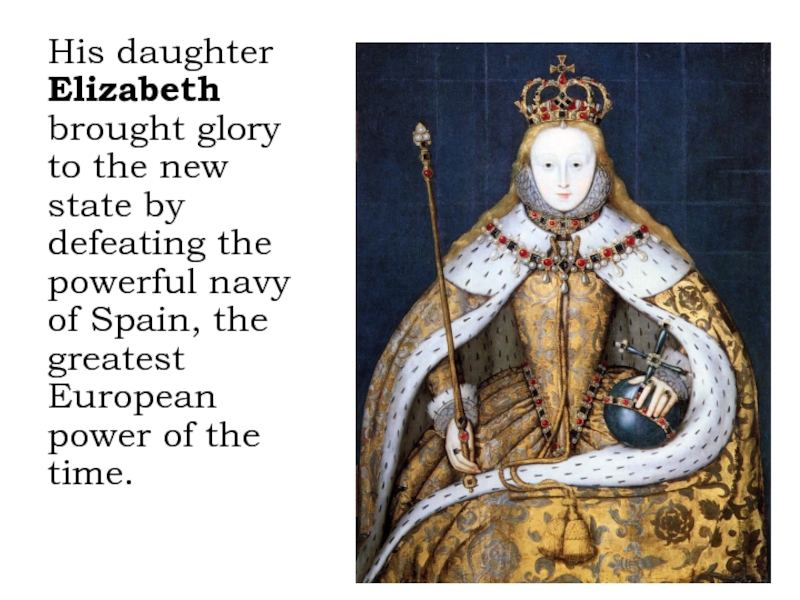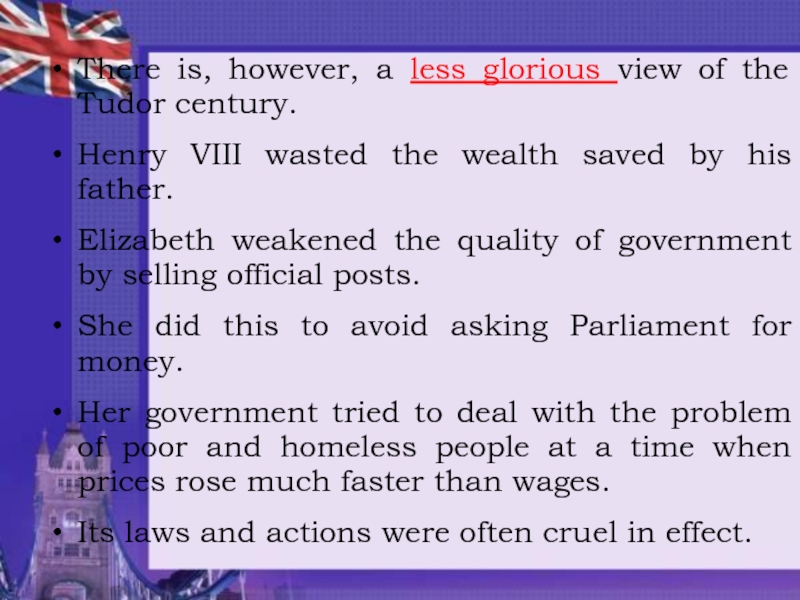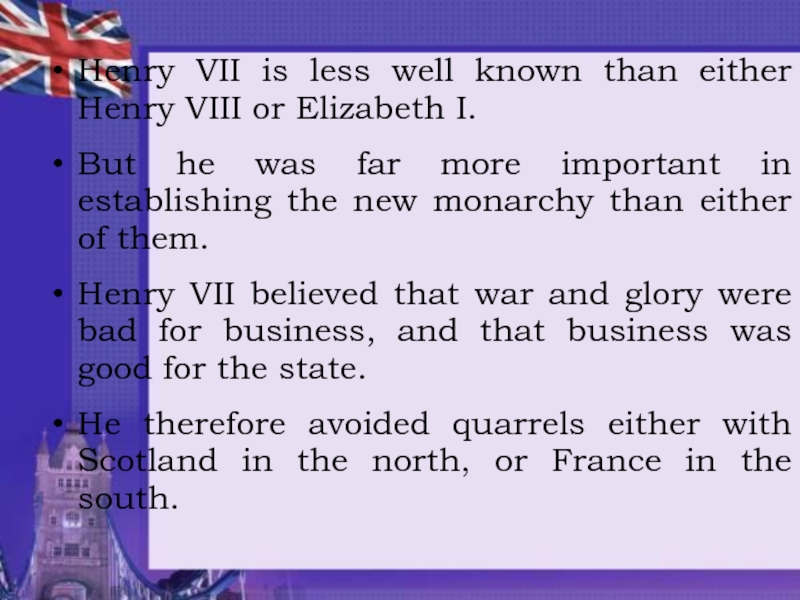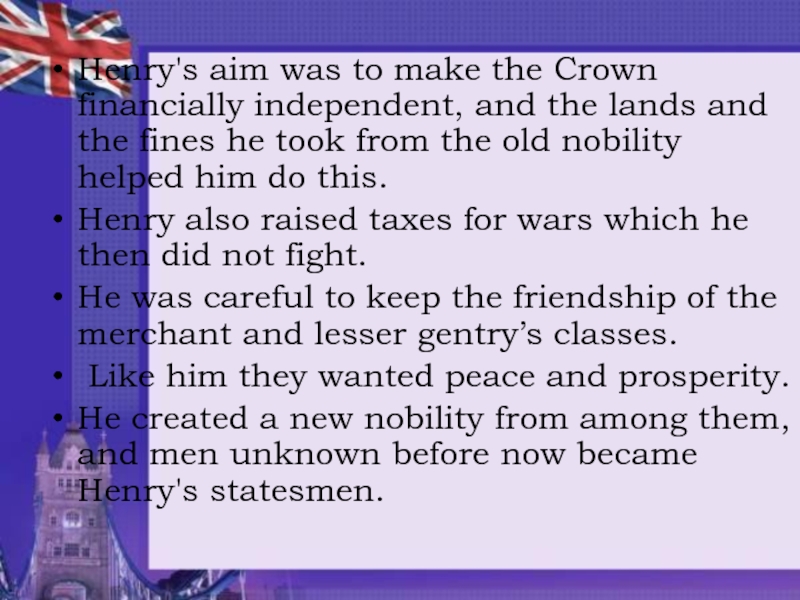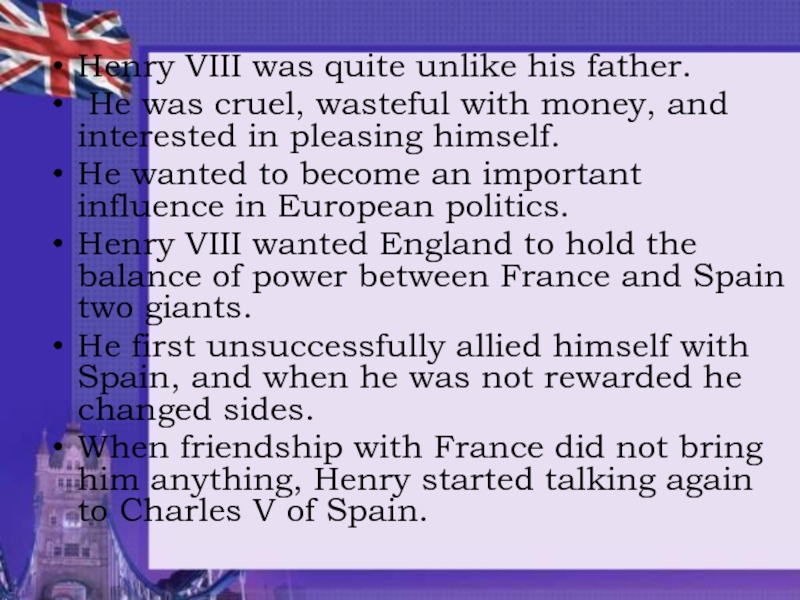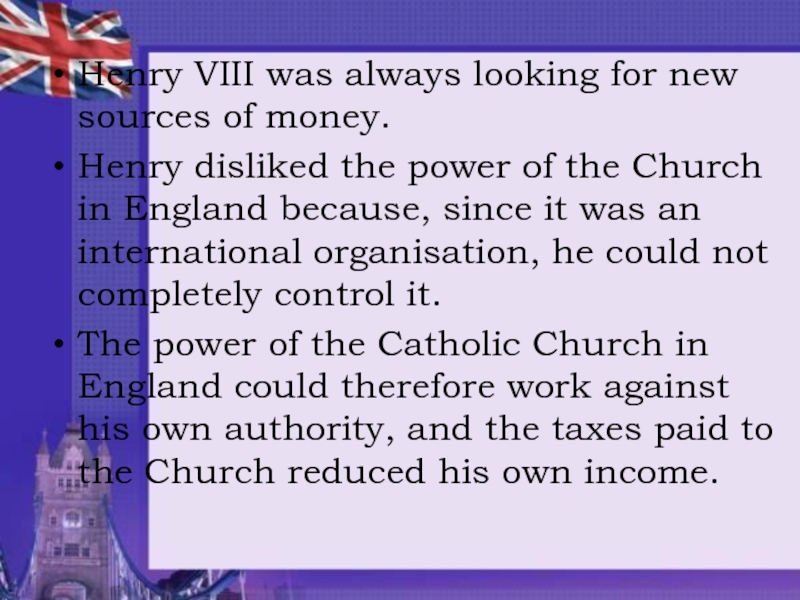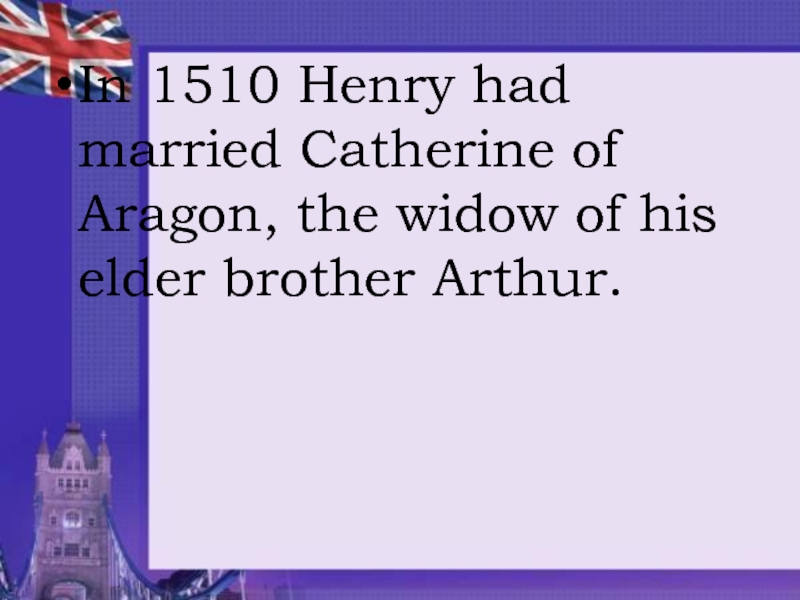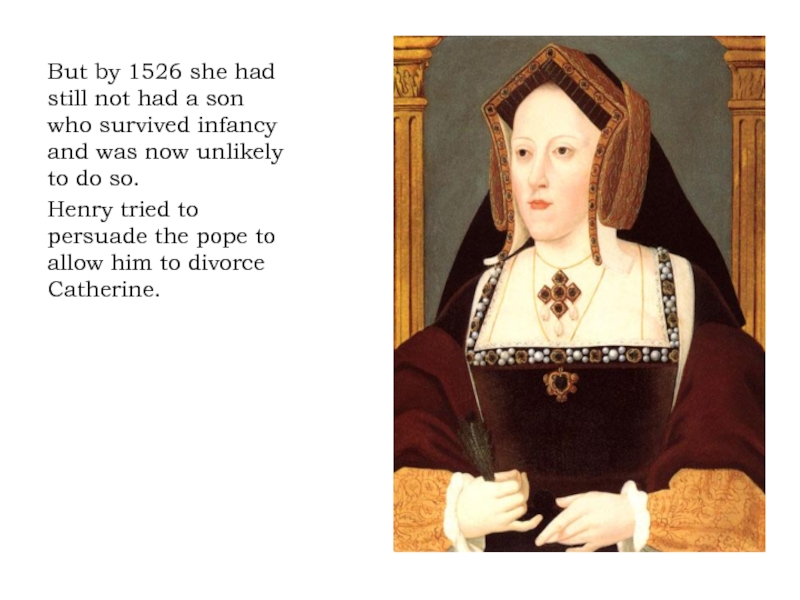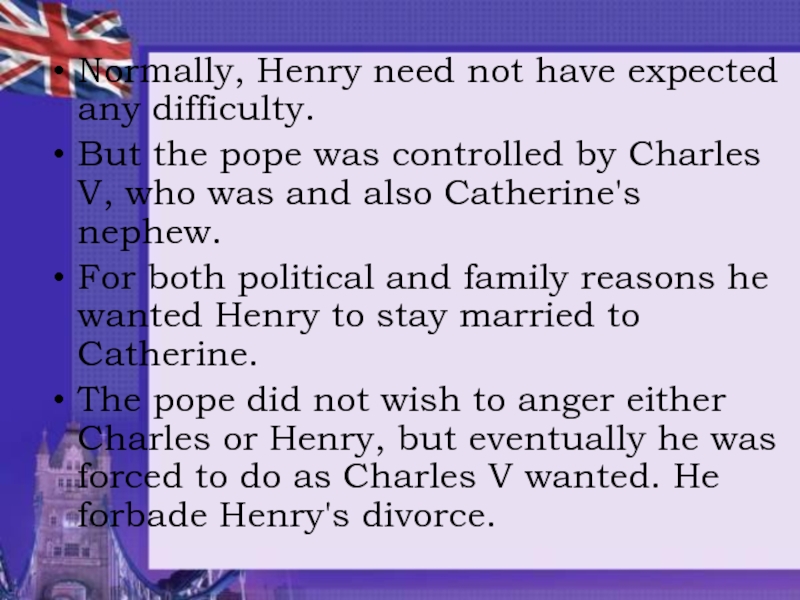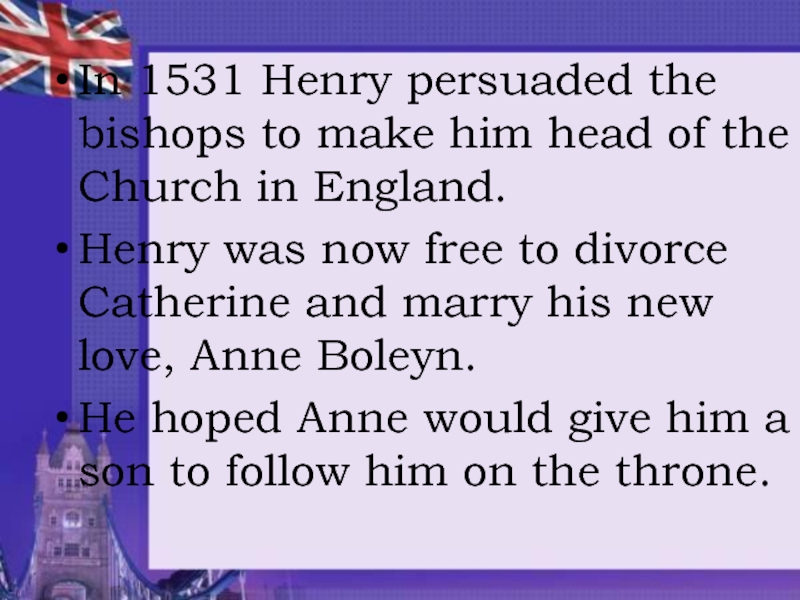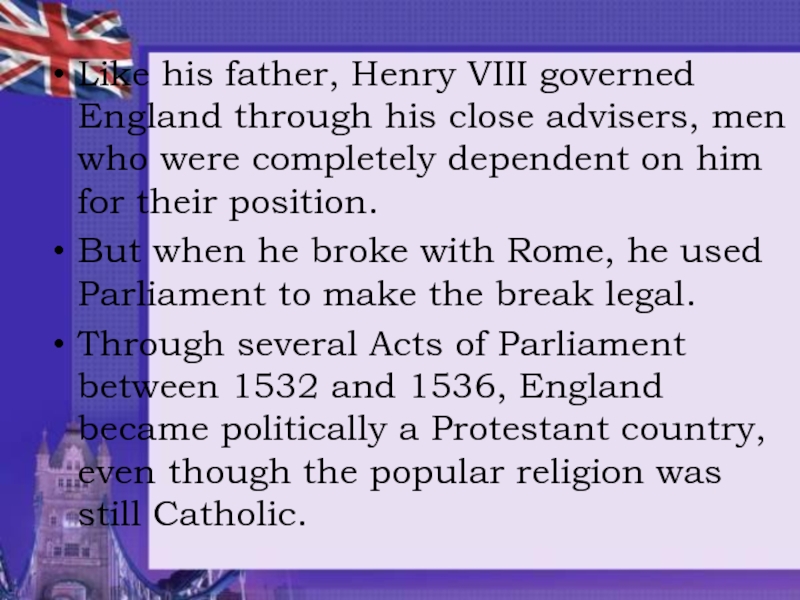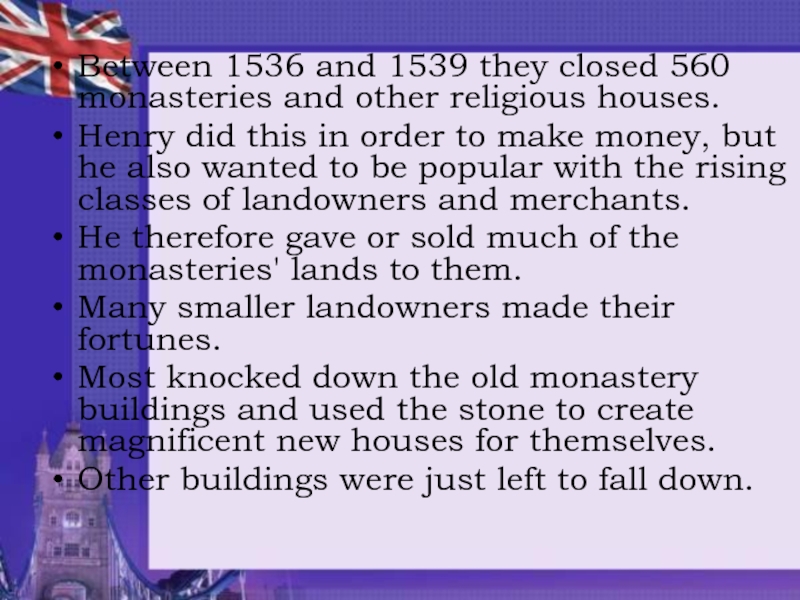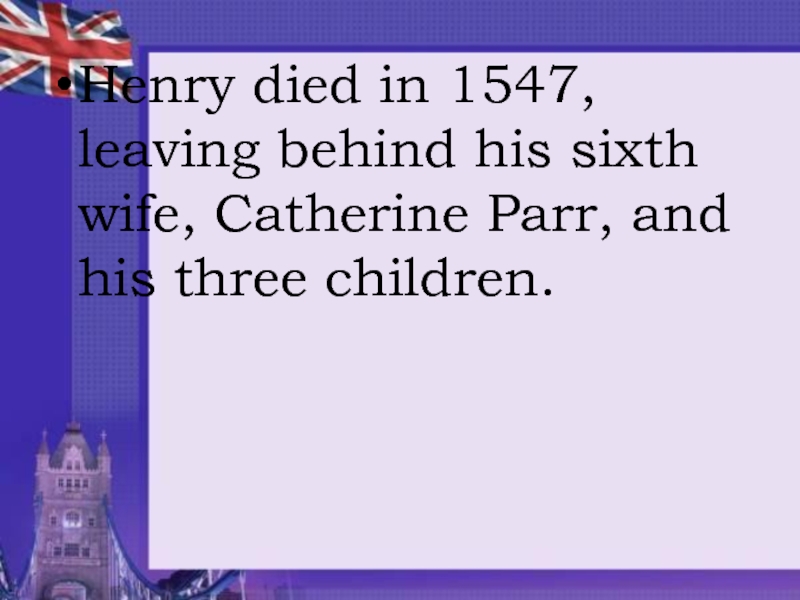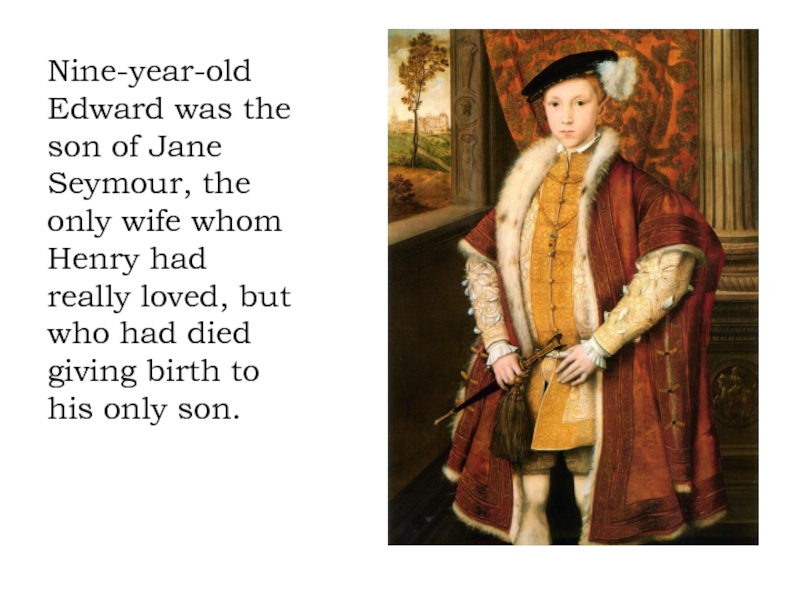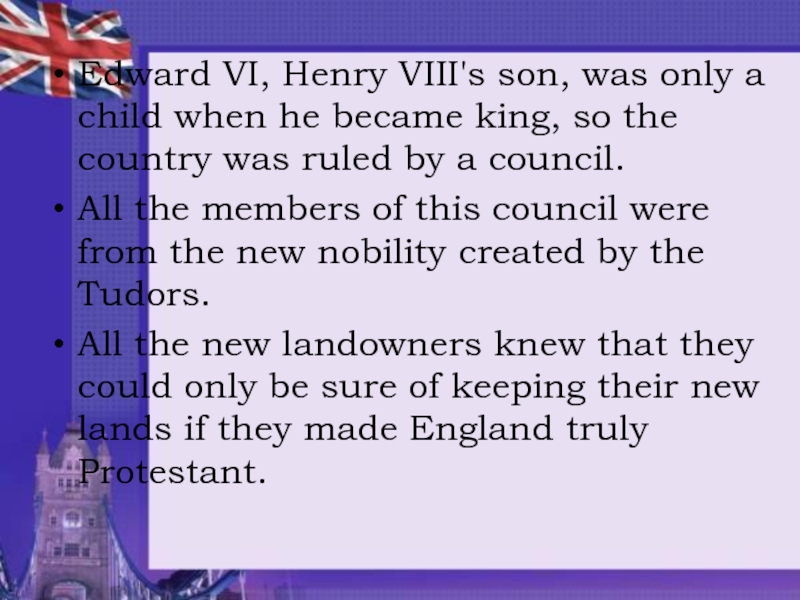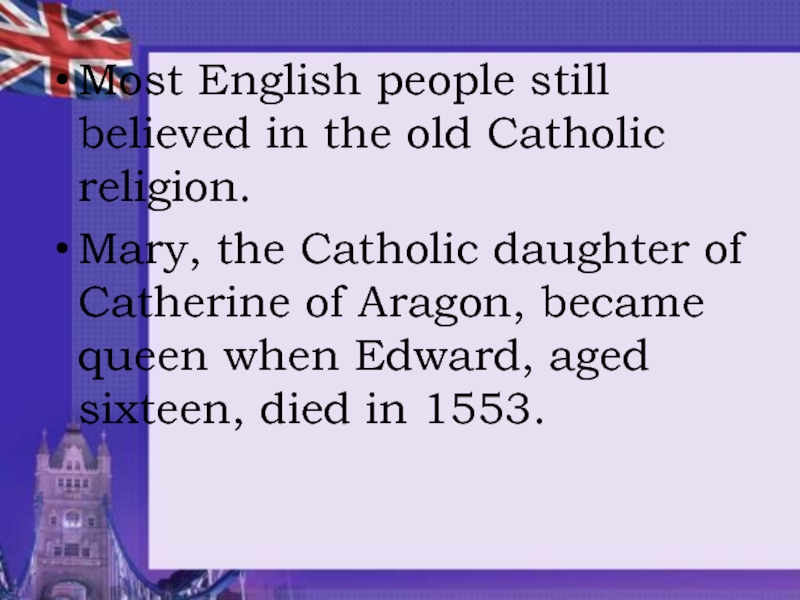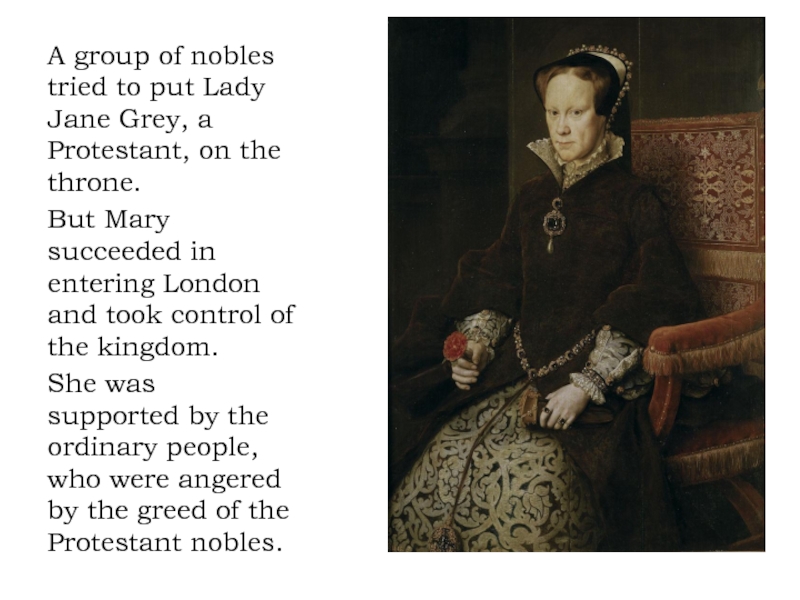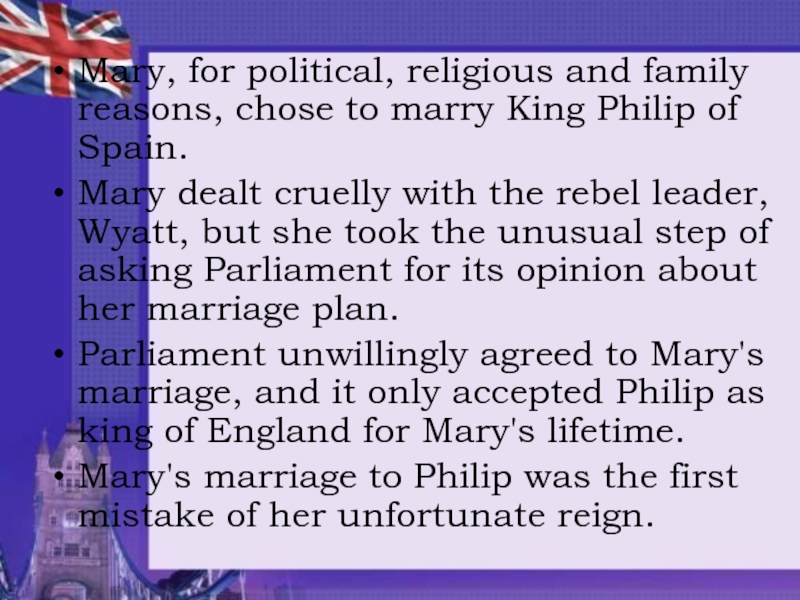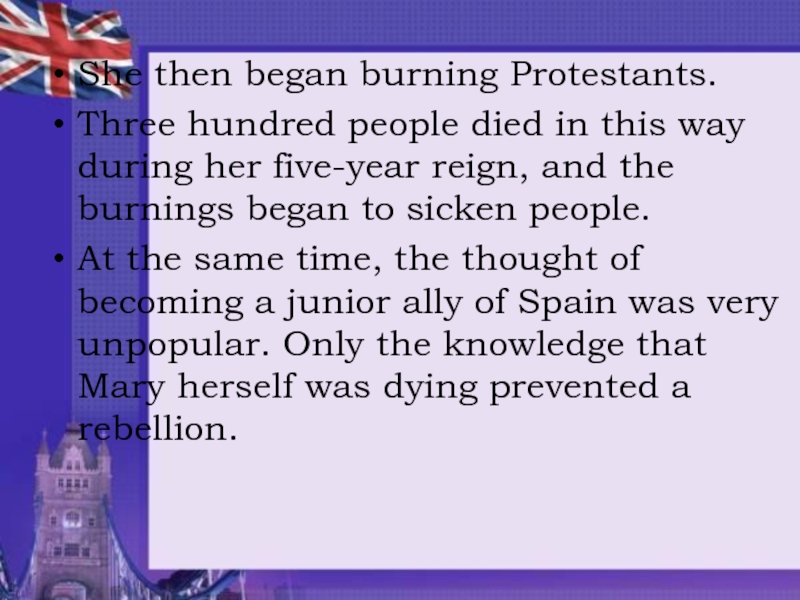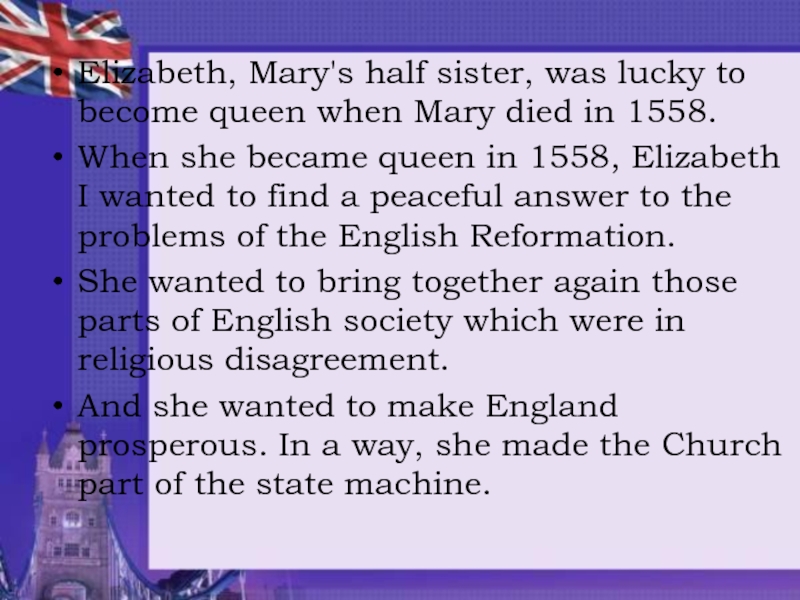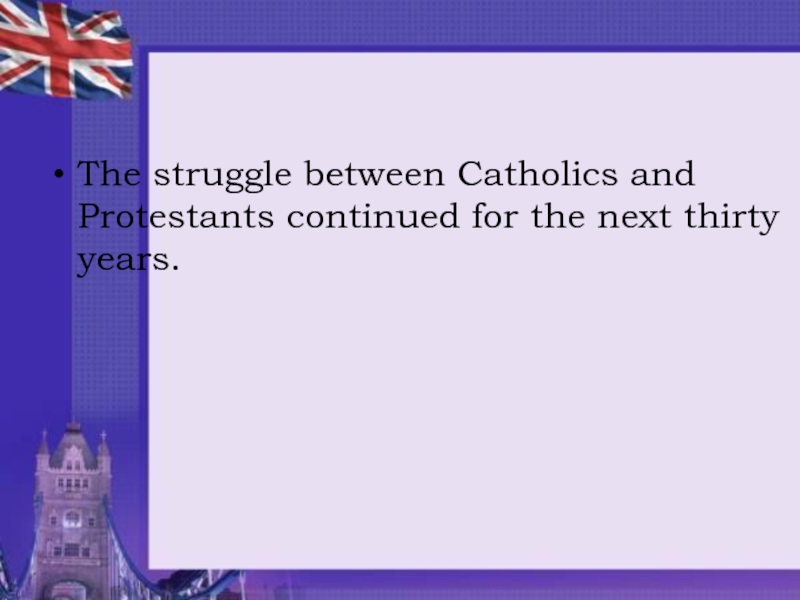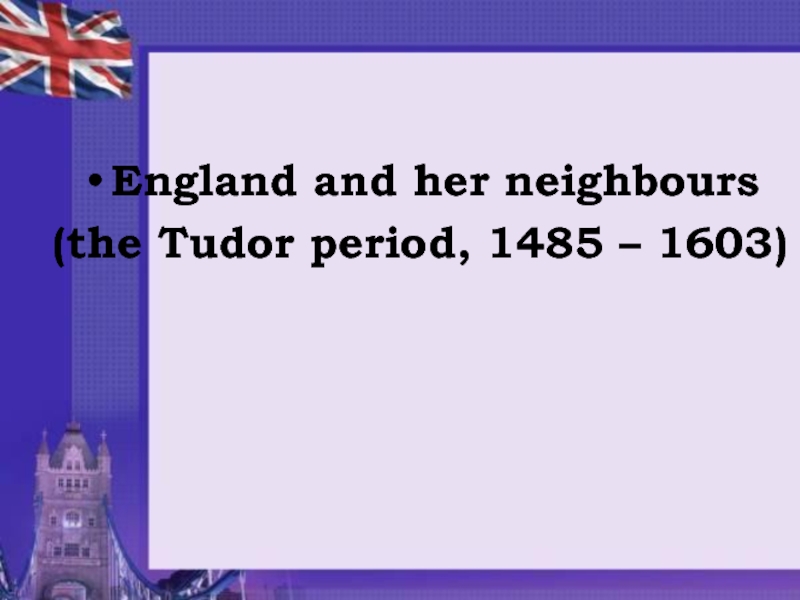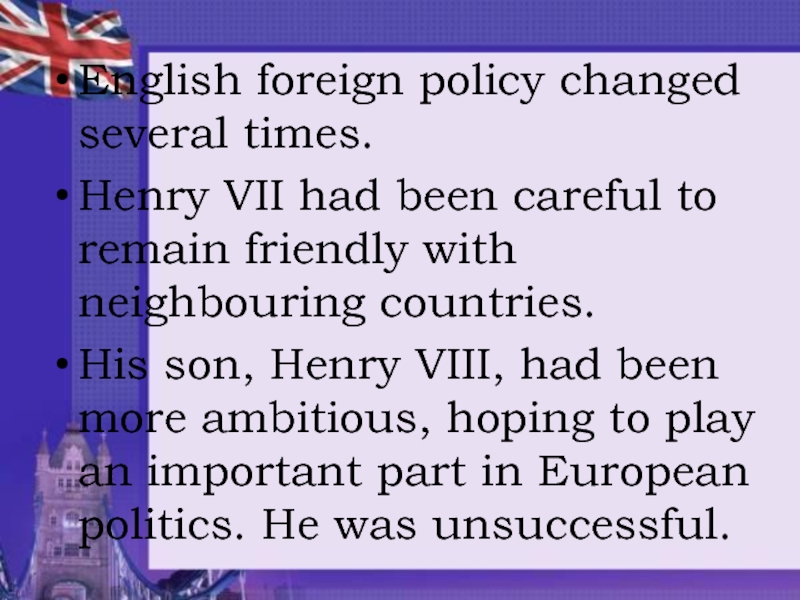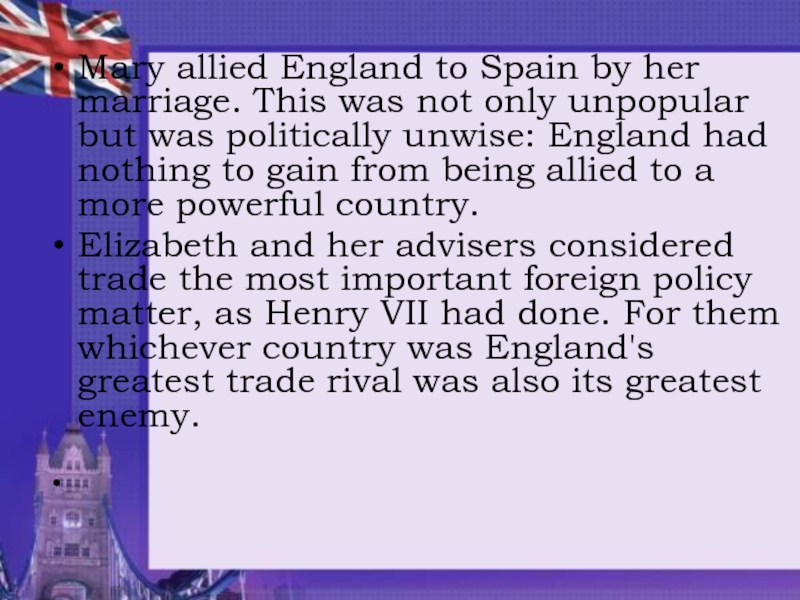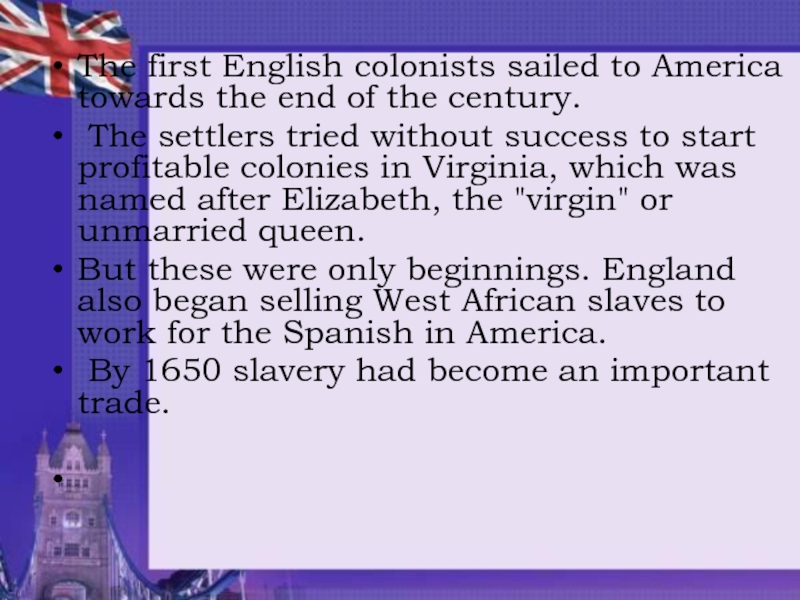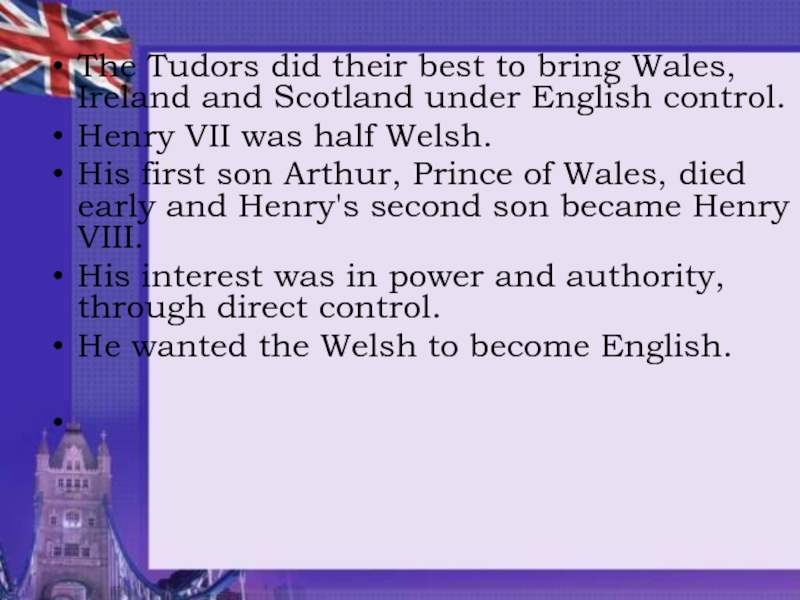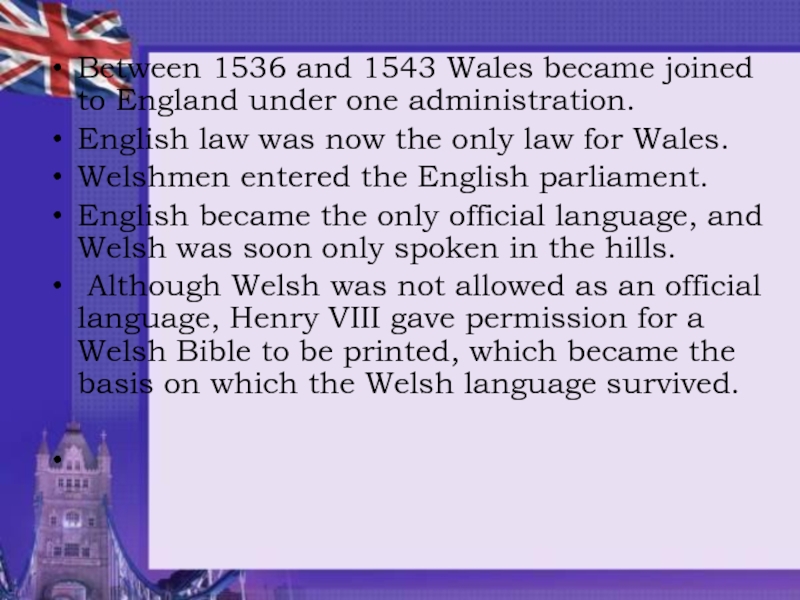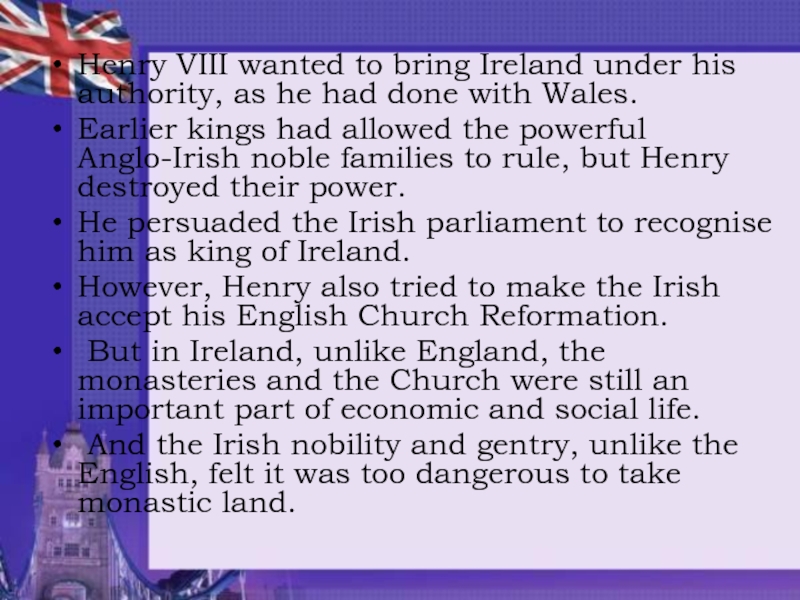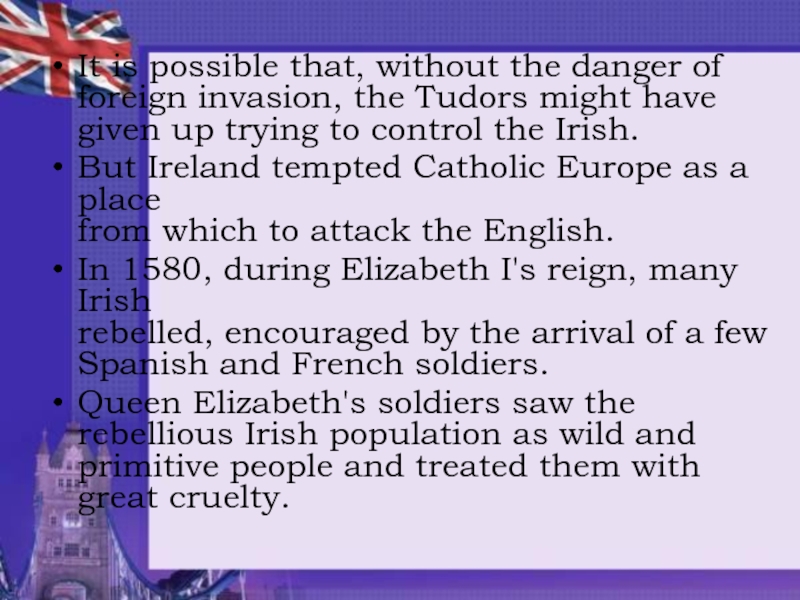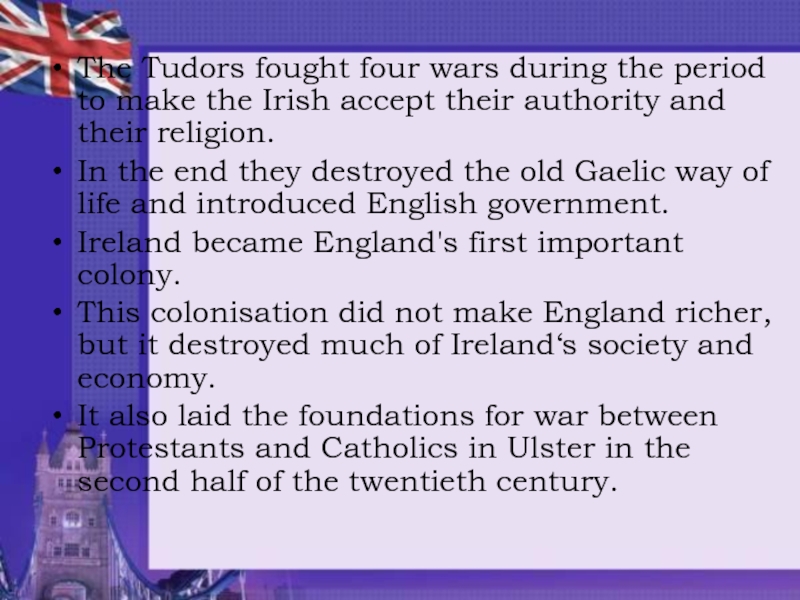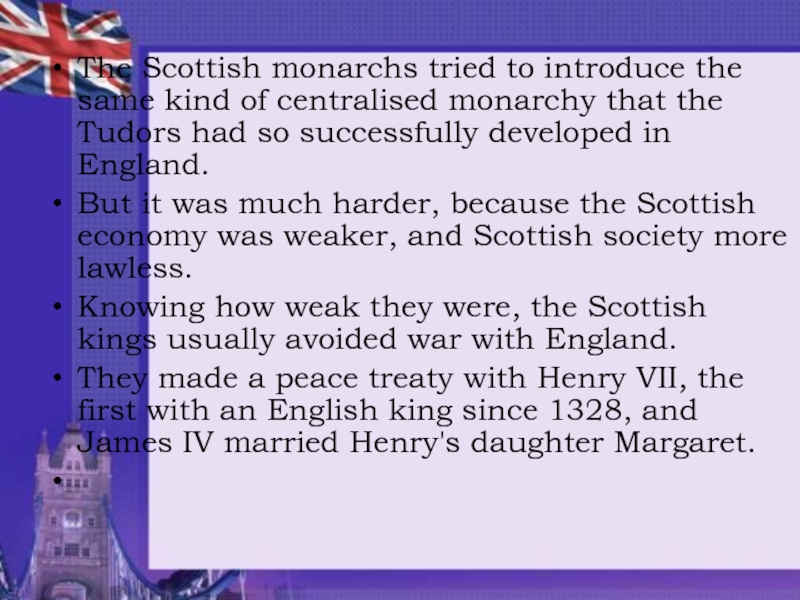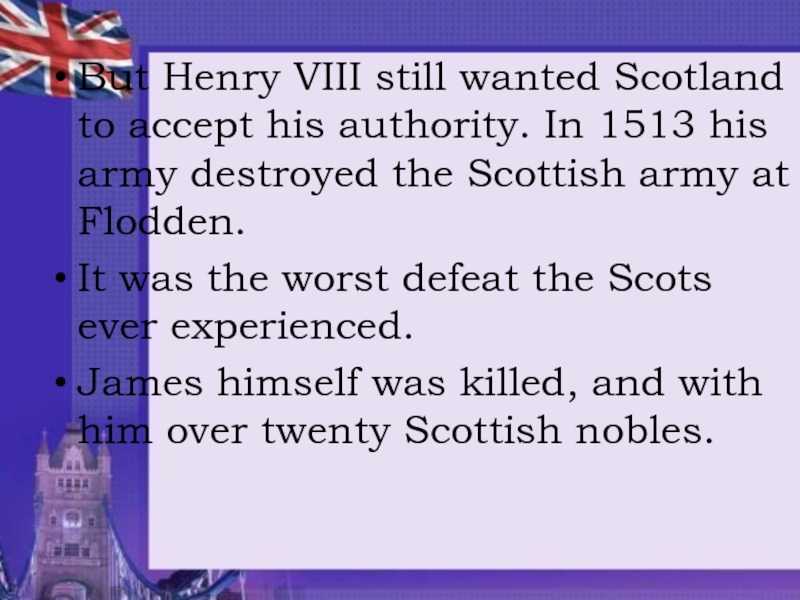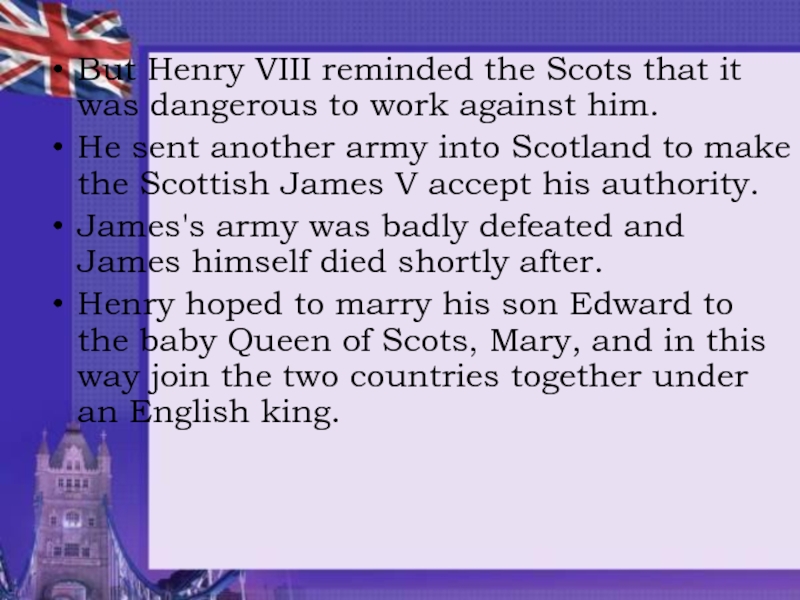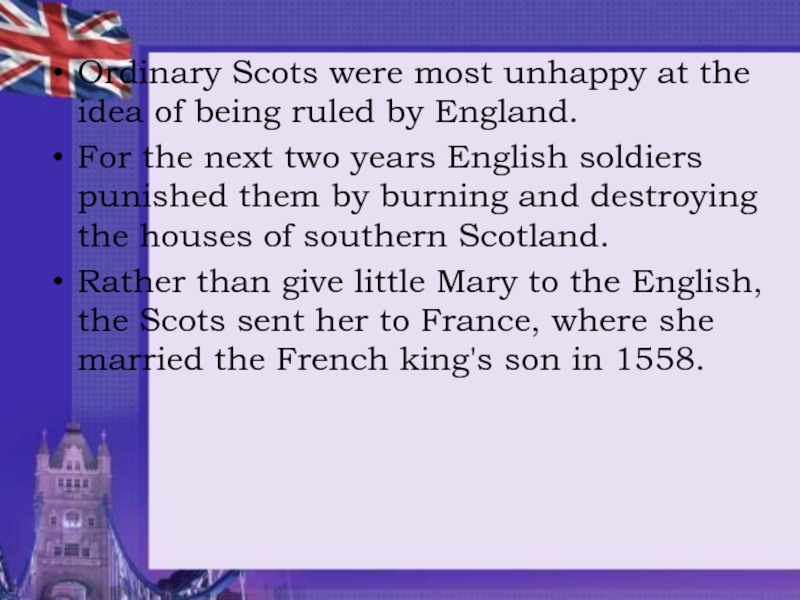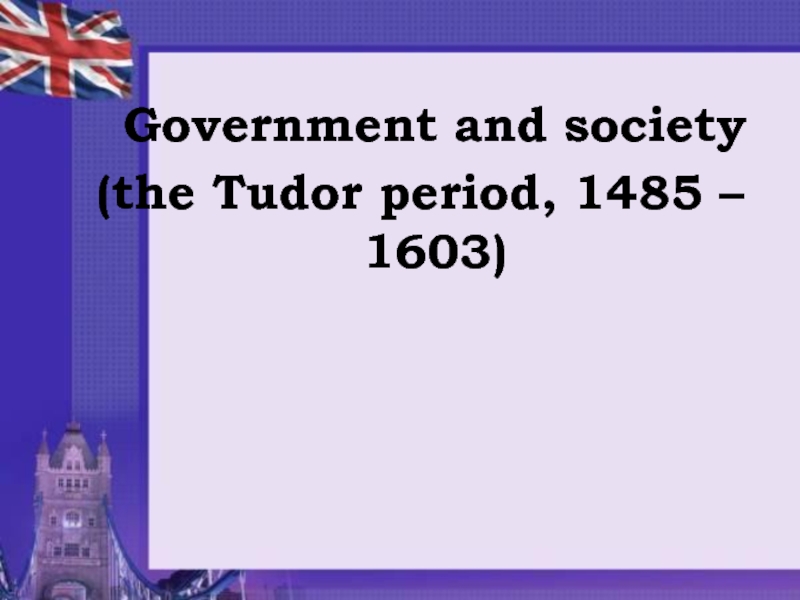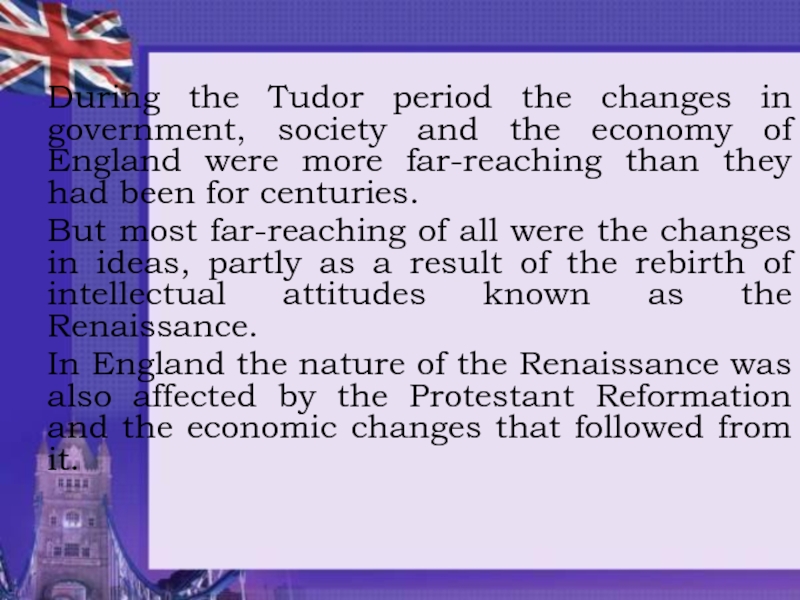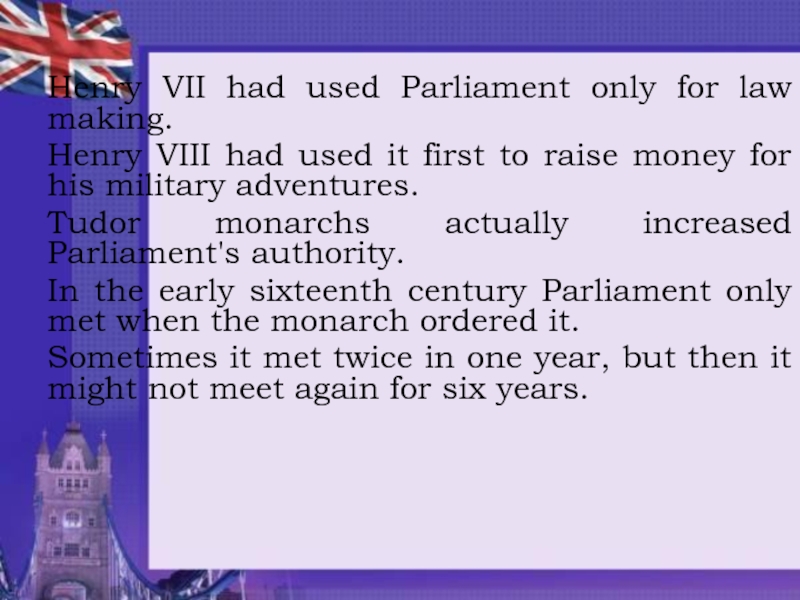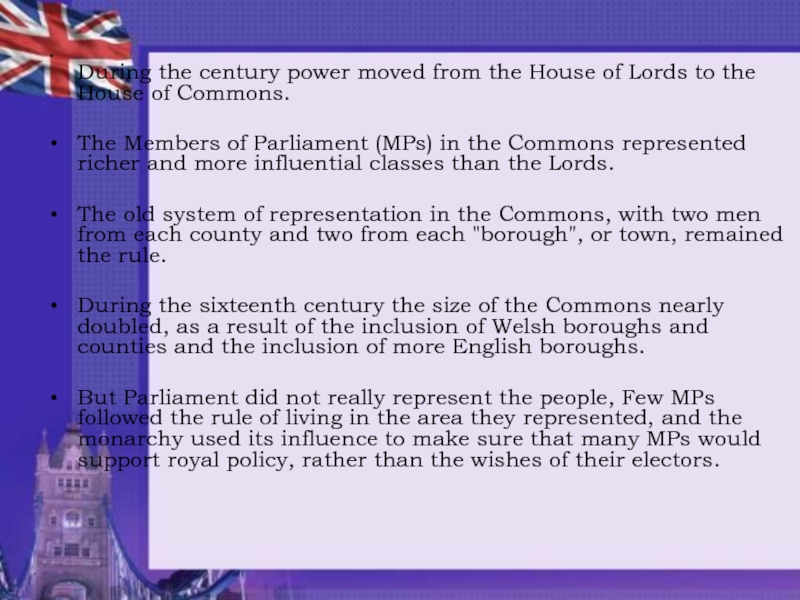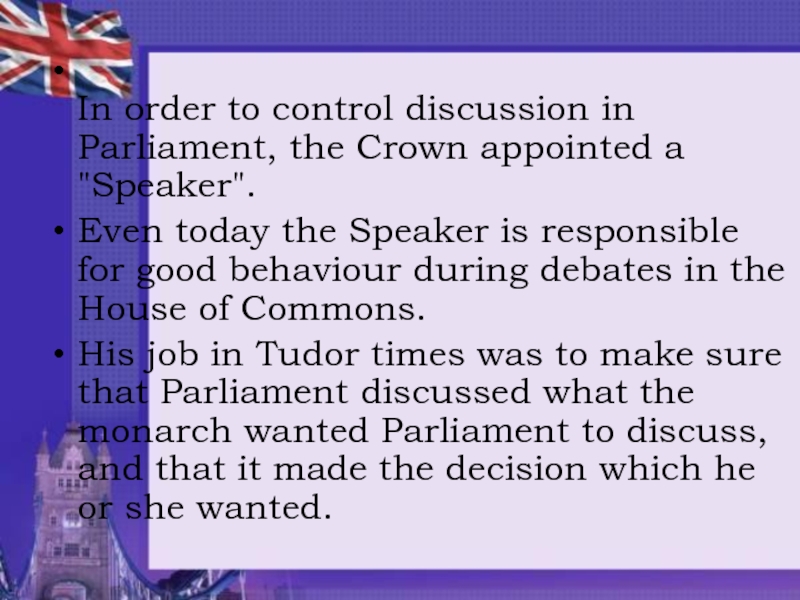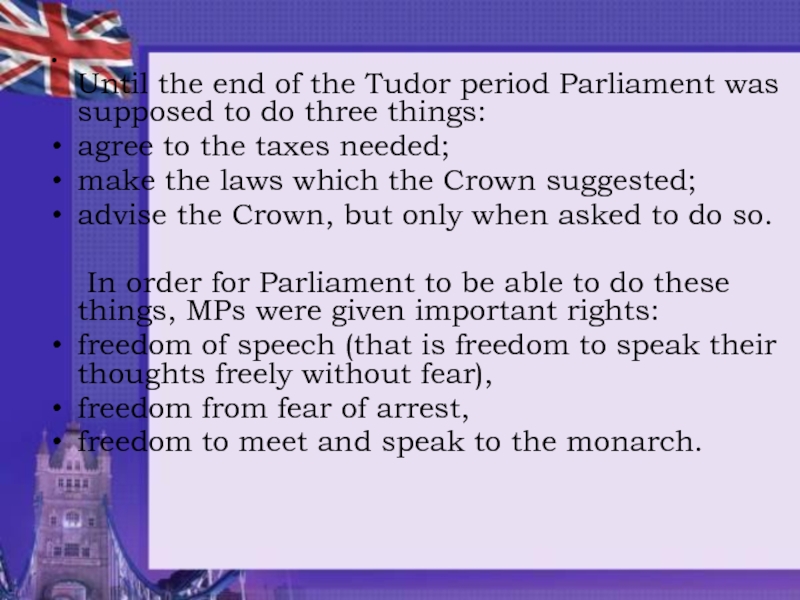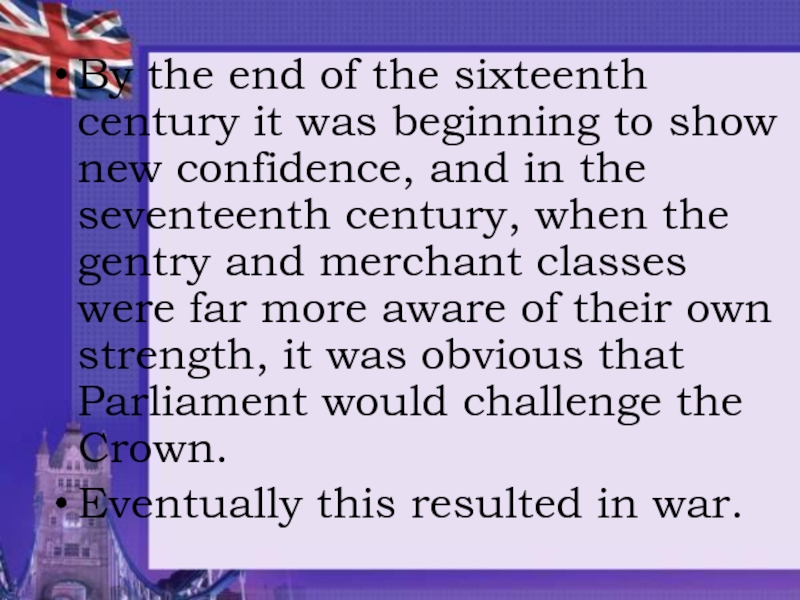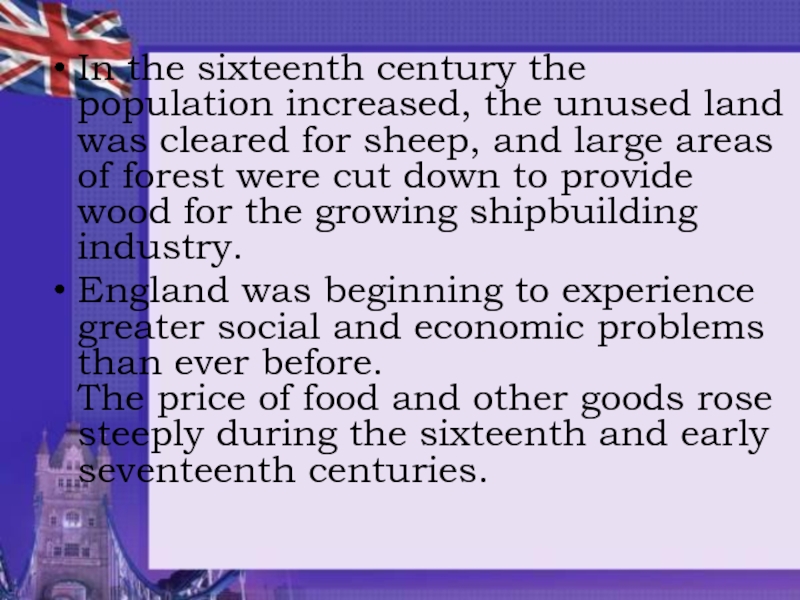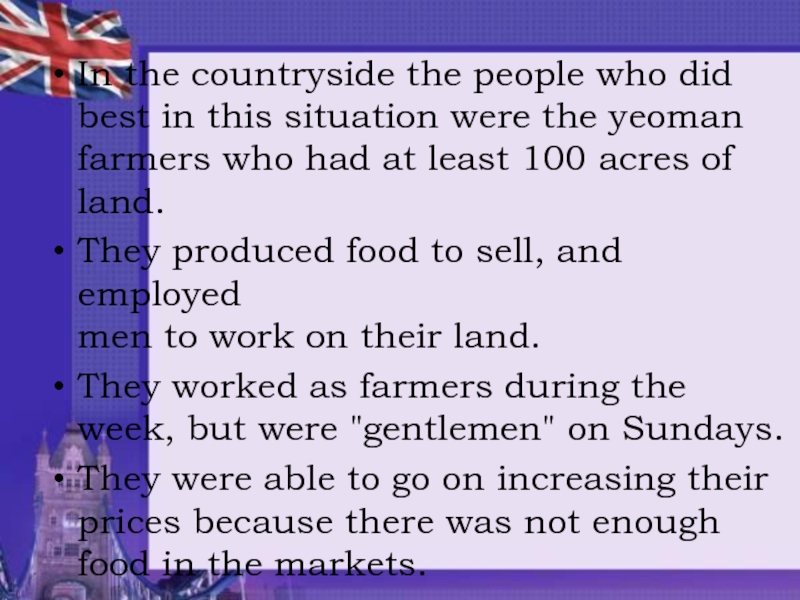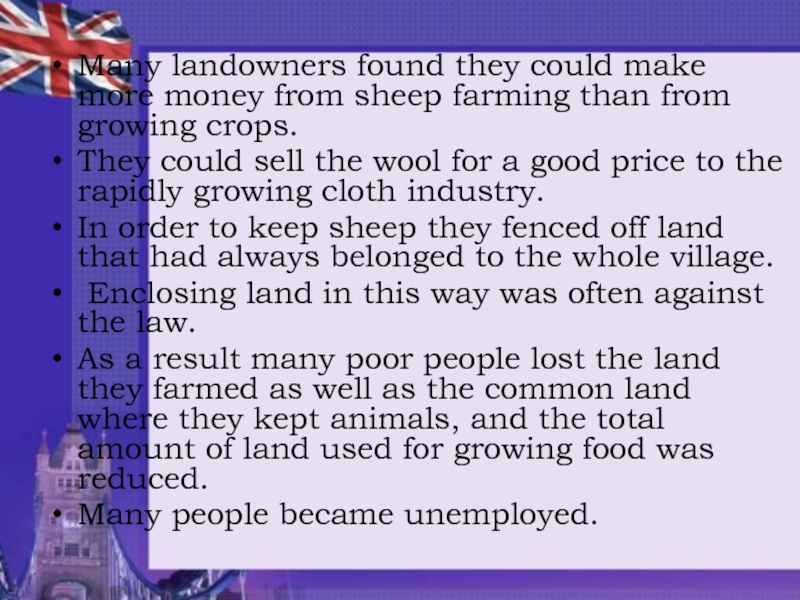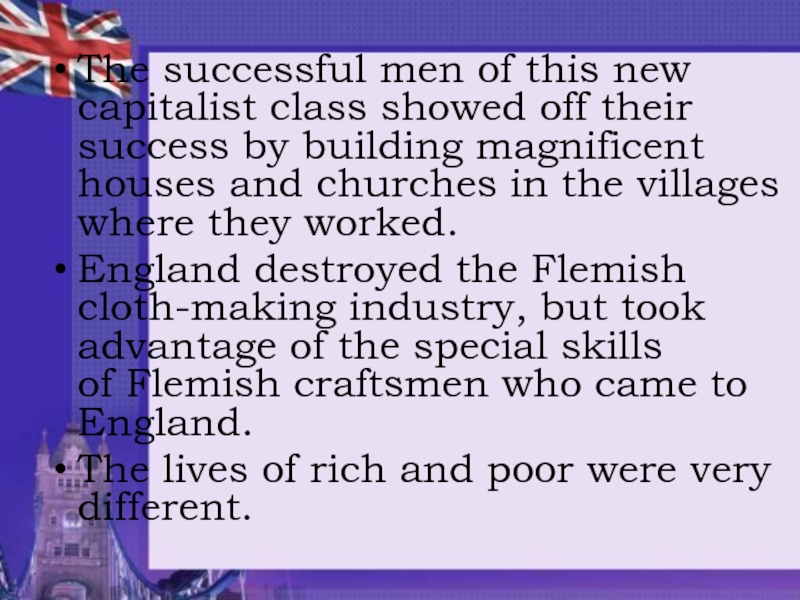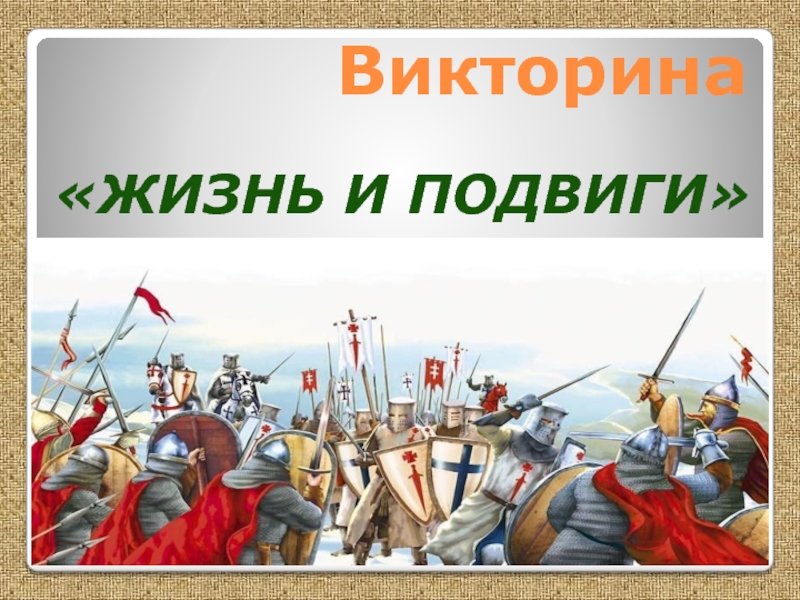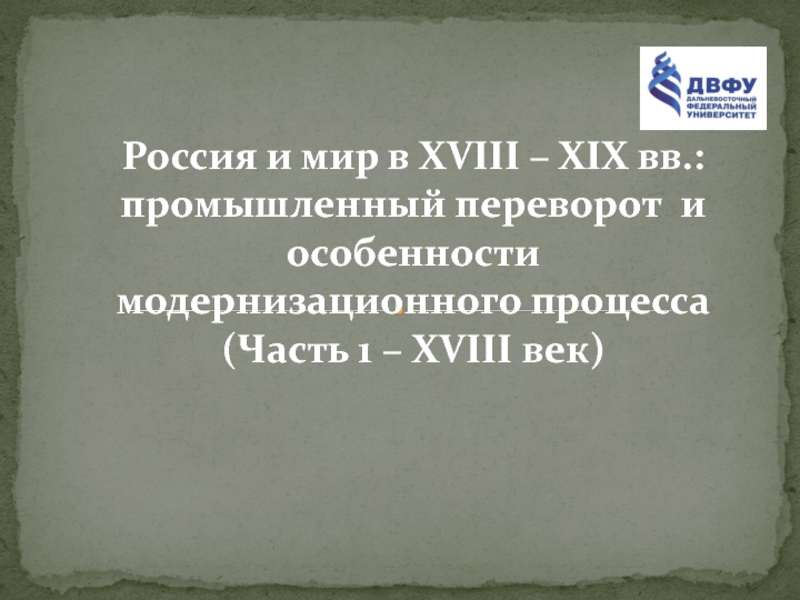- Главная
- Разное
- Дизайн
- Бизнес и предпринимательство
- Аналитика
- Образование
- Развлечения
- Красота и здоровье
- Финансы
- Государство
- Путешествия
- Спорт
- Недвижимость
- Армия
- Графика
- Культурология
- Еда и кулинария
- Лингвистика
- Английский язык
- Астрономия
- Алгебра
- Биология
- География
- Детские презентации
- Информатика
- История
- Литература
- Маркетинг
- Математика
- Медицина
- Менеджмент
- Музыка
- МХК
- Немецкий язык
- ОБЖ
- Обществознание
- Окружающий мир
- Педагогика
- Русский язык
- Технология
- Физика
- Философия
- Химия
- Шаблоны, картинки для презентаций
- Экология
- Экономика
- Юриспруденция
The Tudors (1485-1603) презентация
Содержание
- 1. The Tudors (1485-1603)
- 2. The century of Tudor rule is a most glorious period in English history.
- 3. Henry VII built the foundations of a
- 4. His son, Henry VIII, kept a magnificent
- 5. His daughter Elizabeth brought glory to the
- 6. There is, however, a less glorious view
- 7. Henry VII is less well known than
- 8. Henry's aim was to make the Crown
- 9. Henry VIII was quite unlike his father.
- 10. Henry VIII was always looking for new
- 11. In 1510 Henry had married Catherine of
- 12. But by 1526 she had still not
- 13. Normally, Henry need not have expected any
- 14. In 1531 Henry persuaded the bishops to
- 15. Like his father, Henry VIII governed England
- 16. Between 1536 and 1539 they closed 560
- 17. Henry died in 1547, leaving behind his
- 18. Nine-year-old Edward was the son of Jane
- 19. Edward VI, Henry VIII's son, was only
- 20. Most English people still believed in the
- 21. A group of nobles tried to put
- 22. Mary, for political, religious and family reasons,
- 23. She then began burning Protestants. Three
- 24. Elizabeth, Mary's half sister, was lucky to
- 25. The struggle between Catholics and
- 26. England and her neighbours (the Tudor period, 1485 – 1603)
- 27. English foreign policy changed several times.
- 28. Mary allied England to Spain by her
- 29. The first English colonists sailed to America
- 30. The Tudors did their best to bring
- 31. Between 1536 and 1543 Wales became joined
- 32. Henry VIII wanted to bring Ireland under
- 33. It is possible that, without the danger
- 34. The Tudors fought four wars during the
- 35. The Scottish monarchs tried to introduce the
- 36. But Henry VIII still wanted Scotland to
- 37. But Henry VIII reminded the Scots that
- 38. Ordinary Scots were most unhappy at the
- 39. Government and society (the Tudor period, 1485 – 1603)
- 40. During the Tudor period the changes
- 41. Henry VII had used Parliament only
- 42. During the century power moved from
- 43. In order to control discussion in
- 44. Until the end of the Tudor
- 45. By the end of the sixteenth century
- 46. In the sixteenth century the population increased,
- 47. In the countryside the people who did
- 48. Many landowners found they could make more
- 49. The successful men of this new capitalist
Слайд 4His son, Henry VIII, kept a magnificent court, and made the
Church in England truly English by breaking away from the Roman Catholic Church.
Слайд 5His daughter Elizabeth brought glory to the new state by defeating
the powerful navy of Spain, the greatest European power of the time.
Слайд 6There is, however, a less glorious view of the Tudor century.
Henry VIII wasted the wealth saved by his father.
Elizabeth weakened the quality of government by selling official posts.
She did this to avoid asking Parliament for money.
Her government tried to deal with the problem of poor and homeless people at a time when prices rose much faster than wages.
Its laws and actions were often cruel in effect.
Слайд 7Henry VII is less well known than either Henry VIII or
Elizabeth I.
But he was far more important in establishing the new monarchy than either of them.
Henry VII believed that war and glory were bad for business, and that business was good for the state.
He therefore avoided quarrels either with Scotland in the north, or France in the south.
But he was far more important in establishing the new monarchy than either of them.
Henry VII believed that war and glory were bad for business, and that business was good for the state.
He therefore avoided quarrels either with Scotland in the north, or France in the south.
Слайд 8Henry's aim was to make the Crown financially independent, and the
lands and the fines he took from the old nobility helped him do this.
Henry also raised taxes for wars which he then did not fight.
He was careful to keep the friendship of the merchant and lesser gentry’s classes.
Like him they wanted peace and prosperity.
He created a new nobility from among them, and men unknown before now became Henry's statesmen.
Henry also raised taxes for wars which he then did not fight.
He was careful to keep the friendship of the merchant and lesser gentry’s classes.
Like him they wanted peace and prosperity.
He created a new nobility from among them, and men unknown before now became Henry's statesmen.
Слайд 9Henry VIII was quite unlike his father.
He was cruel, wasteful
with money, and interested in pleasing himself.
He wanted to become an important influence in European politics.
Henry VIII wanted England to hold the balance of power between France and Spain two giants.
He first unsuccessfully allied himself with Spain, and when he was not rewarded he changed sides.
When friendship with France did not bring him anything, Henry started talking again to Charles V of Spain.
He wanted to become an important influence in European politics.
Henry VIII wanted England to hold the balance of power between France and Spain two giants.
He first unsuccessfully allied himself with Spain, and when he was not rewarded he changed sides.
When friendship with France did not bring him anything, Henry started talking again to Charles V of Spain.
Слайд 10Henry VIII was always looking for new sources of money.
Henry disliked
the power of the Church in England because, since it was an international organisation, he could not completely control it.
The power of the Catholic Church in England could therefore work against his own authority, and the taxes paid to the Church reduced his own income.
The power of the Catholic Church in England could therefore work against his own authority, and the taxes paid to the Church reduced his own income.
Слайд 12But by 1526 she had still not had a son who
survived infancy and was now unlikely to do so.
Henry tried to persuade the pope to allow him to divorce Catherine.
Henry tried to persuade the pope to allow him to divorce Catherine.
Слайд 13Normally, Henry need not have expected any difficulty.
But the pope
was controlled by Charles V, who was and also Catherine's nephew.
For both political and family reasons he wanted Henry to stay married to Catherine.
The pope did not wish to anger either Charles or Henry, but eventually he was forced to do as Charles V wanted. He forbade Henry's divorce.
For both political and family reasons he wanted Henry to stay married to Catherine.
The pope did not wish to anger either Charles or Henry, but eventually he was forced to do as Charles V wanted. He forbade Henry's divorce.
Слайд 14In 1531 Henry persuaded the bishops to make him head of
the Church in England.
Henry was now free to divorce Catherine and marry his new love, Anne Boleyn.
He hoped Anne would give him a son to follow him on the throne.
Henry was now free to divorce Catherine and marry his new love, Anne Boleyn.
He hoped Anne would give him a son to follow him on the throne.
Слайд 15Like his father, Henry VIII governed England through his close advisers,
men who were completely dependent on him for their position.
But when he broke with Rome, he used Parliament to make the break legal.
Through several Acts of Parliament between 1532 and 1536, England became politically a Protestant country, even though the popular religion was still Catholic.
But when he broke with Rome, he used Parliament to make the break legal.
Through several Acts of Parliament between 1532 and 1536, England became politically a Protestant country, even though the popular religion was still Catholic.
Слайд 16Between 1536 and 1539 they closed 560 monasteries and other religious
houses.
Henry did this in order to make money, but he also wanted to be popular with the rising classes of landowners and merchants.
He therefore gave or sold much of the monasteries' lands to them.
Many smaller landowners made their fortunes.
Most knocked down the old monastery buildings and used the stone to create magnificent new houses for themselves.
Other buildings were just left to fall down.
Henry did this in order to make money, but he also wanted to be popular with the rising classes of landowners and merchants.
He therefore gave or sold much of the monasteries' lands to them.
Many smaller landowners made their fortunes.
Most knocked down the old monastery buildings and used the stone to create magnificent new houses for themselves.
Other buildings were just left to fall down.
Слайд 18Nine-year-old Edward was the son of Jane Seymour, the only wife
whom Henry had really loved, but who had died giving birth to his only son.
Слайд 19Edward VI, Henry VIII's son, was only a child when he
became king, so the country was ruled by a council.
All the members of this council were from the new nobility created by the Tudors.
All the new landowners knew that they could only be sure of keeping their new lands if they made England truly Protestant.
All the members of this council were from the new nobility created by the Tudors.
All the new landowners knew that they could only be sure of keeping their new lands if they made England truly Protestant.
Слайд 20Most English people still believed in the old Catholic religion.
Mary,
the Catholic daughter of Catherine of Aragon, became queen when Edward, aged sixteen, died in 1553.
Слайд 21A group of nobles tried to put Lady Jane Grey, a
Protestant, on the throne.
But Mary succeeded in entering London and took control of the kingdom.
She was supported by the ordinary people, who were angered by the greed of the Protestant nobles.
But Mary succeeded in entering London and took control of the kingdom.
She was supported by the ordinary people, who were angered by the greed of the Protestant nobles.
Слайд 22Mary, for political, religious and family reasons, chose to marry King
Philip of Spain.
Mary dealt cruelly with the rebel leader, Wyatt, but she took the unusual step of asking Parliament for its opinion about her marriage plan.
Parliament unwillingly agreed to Mary's marriage, and it only accepted Philip as king of England for Mary's lifetime.
Mary's marriage to Philip was the first mistake of her unfortunate reign.
Mary dealt cruelly with the rebel leader, Wyatt, but she took the unusual step of asking Parliament for its opinion about her marriage plan.
Parliament unwillingly agreed to Mary's marriage, and it only accepted Philip as king of England for Mary's lifetime.
Mary's marriage to Philip was the first mistake of her unfortunate reign.
Слайд 23She then began burning Protestants.
Three hundred people died in this
way during her five-year reign, and the burnings began to sicken people.
At the same time, the thought of becoming a junior ally of Spain was very unpopular. Only the knowledge that Mary herself was dying prevented a rebellion.
At the same time, the thought of becoming a junior ally of Spain was very unpopular. Only the knowledge that Mary herself was dying prevented a rebellion.
Слайд 24Elizabeth, Mary's half sister, was lucky to become queen when Mary
died in 1558.
When she became queen in 1558, Elizabeth I wanted to find a peaceful answer to the problems of the English Reformation.
She wanted to bring together again those parts of English society which were in religious disagreement.
And she wanted to make England prosperous. In a way, she made the Church part of the state machine.
When she became queen in 1558, Elizabeth I wanted to find a peaceful answer to the problems of the English Reformation.
She wanted to bring together again those parts of English society which were in religious disagreement.
And she wanted to make England prosperous. In a way, she made the Church part of the state machine.
Слайд 27English foreign policy changed several times.
Henry VII had been careful
to remain friendly with neighbouring countries.
His son, Henry VIII, had been more ambitious, hoping to play an important part in European politics. He was unsuccessful.
His son, Henry VIII, had been more ambitious, hoping to play an important part in European politics. He was unsuccessful.
Слайд 28Mary allied England to Spain by her marriage. This was not
only unpopular but was politically unwise: England had nothing to gain from being allied to a more powerful country.
Elizabeth and her advisers considered trade the most important foreign policy matter, as Henry VII had done. For them whichever country was England's greatest trade rival was also its greatest enemy.
Elizabeth and her advisers considered trade the most important foreign policy matter, as Henry VII had done. For them whichever country was England's greatest trade rival was also its greatest enemy.
Слайд 29The first English colonists sailed to America towards the end of
the century.
The settlers tried without success to start profitable colonies in Virginia, which was named after Elizabeth, the "virgin" or unmarried queen.
But these were only beginnings. England also began selling West African slaves to work for the Spanish in America.
By 1650 slavery had become an important trade.
The settlers tried without success to start profitable colonies in Virginia, which was named after Elizabeth, the "virgin" or unmarried queen.
But these were only beginnings. England also began selling West African slaves to work for the Spanish in America.
By 1650 slavery had become an important trade.
Слайд 30The Tudors did their best to bring Wales, Ireland and Scotland
under English control.
Henry VII was half Welsh.
His first son Arthur, Prince of Wales, died early and Henry's second son became Henry VIII.
His interest was in power and authority, through direct control.
He wanted the Welsh to become English.
Henry VII was half Welsh.
His first son Arthur, Prince of Wales, died early and Henry's second son became Henry VIII.
His interest was in power and authority, through direct control.
He wanted the Welsh to become English.
Слайд 31Between 1536 and 1543 Wales became joined to England under one
administration.
English law was now the only law for Wales.
Welshmen entered the English parliament.
English became the only official language, and Welsh was soon only spoken in the hills.
Although Welsh was not allowed as an official language, Henry VIII gave permission for a Welsh Bible to be printed, which became the basis on which the Welsh language survived.
English law was now the only law for Wales.
Welshmen entered the English parliament.
English became the only official language, and Welsh was soon only spoken in the hills.
Although Welsh was not allowed as an official language, Henry VIII gave permission for a Welsh Bible to be printed, which became the basis on which the Welsh language survived.
Слайд 32Henry VIII wanted to bring Ireland under his authority, as he
had done with Wales.
Earlier kings had allowed the powerful Anglo-Irish noble families to rule, but Henry destroyed their power.
He persuaded the Irish parliament to recognise him as king of Ireland.
However, Henry also tried to make the Irish accept his English Church Reformation.
But in Ireland, unlike England, the monasteries and the Church were still an important part of economic and social life.
And the Irish nobility and gentry, unlike the English, felt it was too dangerous to take monastic land.
Earlier kings had allowed the powerful Anglo-Irish noble families to rule, but Henry destroyed their power.
He persuaded the Irish parliament to recognise him as king of Ireland.
However, Henry also tried to make the Irish accept his English Church Reformation.
But in Ireland, unlike England, the monasteries and the Church were still an important part of economic and social life.
And the Irish nobility and gentry, unlike the English, felt it was too dangerous to take monastic land.
Слайд 33It is possible that, without the danger of foreign invasion, the
Tudors might have
given up trying to control the Irish.
But Ireland tempted Catholic Europe as a place from which to attack the English.
In 1580, during Elizabeth I's reign, many Irish rebelled, encouraged by the arrival of a few Spanish and French soldiers.
Queen Elizabeth's soldiers saw the rebellious Irish population as wild and primitive people and treated them with great cruelty.
But Ireland tempted Catholic Europe as a place from which to attack the English.
In 1580, during Elizabeth I's reign, many Irish rebelled, encouraged by the arrival of a few Spanish and French soldiers.
Queen Elizabeth's soldiers saw the rebellious Irish population as wild and primitive people and treated them with great cruelty.
Слайд 34The Tudors fought four wars during the period to make the
Irish accept their authority and their religion.
In the end they destroyed the old Gaelic way of life and introduced English government.
Ireland became England's first important colony.
This colonisation did not make England richer, but it destroyed much of Ireland‘s society and economy.
It also laid the foundations for war between Protestants and Catholics in Ulster in the second half of the twentieth century.
In the end they destroyed the old Gaelic way of life and introduced English government.
Ireland became England's first important colony.
This colonisation did not make England richer, but it destroyed much of Ireland‘s society and economy.
It also laid the foundations for war between Protestants and Catholics in Ulster in the second half of the twentieth century.
Слайд 35The Scottish monarchs tried to introduce the same kind of centralised
monarchy that the Tudors had so successfully developed in England.
But it was much harder, because the Scottish economy was weaker, and Scottish society more lawless.
Knowing how weak they were, the Scottish kings usually avoided war with England.
They made a peace treaty with Henry VII, the first with an English king since 1328, and James IV married Henry's daughter Margaret.
But it was much harder, because the Scottish economy was weaker, and Scottish society more lawless.
Knowing how weak they were, the Scottish kings usually avoided war with England.
They made a peace treaty with Henry VII, the first with an English king since 1328, and James IV married Henry's daughter Margaret.
Слайд 36But Henry VIII still wanted Scotland to accept his authority. In
1513 his army destroyed the Scottish army at Flodden.
It was the worst defeat the Scots ever experienced.
James himself was killed, and with him over twenty Scottish nobles.
It was the worst defeat the Scots ever experienced.
James himself was killed, and with him over twenty Scottish nobles.
Слайд 37But Henry VIII reminded the Scots that it was dangerous to
work against him.
He sent another army into Scotland to make the Scottish James V accept his authority.
James's army was badly defeated and James himself died shortly after.
Henry hoped to marry his son Edward to the baby Queen of Scots, Mary, and in this way join the two countries together under an English king.
He sent another army into Scotland to make the Scottish James V accept his authority.
James's army was badly defeated and James himself died shortly after.
Henry hoped to marry his son Edward to the baby Queen of Scots, Mary, and in this way join the two countries together under an English king.
Слайд 38Ordinary Scots were most unhappy at the idea of being ruled
by England.
For the next two years English soldiers punished them by burning and destroying the houses of southern Scotland.
Rather than give little Mary to the English, the Scots sent her to France, where she married the French king's son in 1558.
For the next two years English soldiers punished them by burning and destroying the houses of southern Scotland.
Rather than give little Mary to the English, the Scots sent her to France, where she married the French king's son in 1558.
Слайд 40 During the Tudor period the changes in government, society and the
economy of
England were more far-reaching than they had been for centuries.
But most far-reaching of all were the changes in ideas, partly as a result of the rebirth of intellectual attitudes known as the Renaissance.
In England the nature of the Renaissance was also affected by the Protestant Reformation and the economic changes that followed from it.
But most far-reaching of all were the changes in ideas, partly as a result of the rebirth of intellectual attitudes known as the Renaissance.
In England the nature of the Renaissance was also affected by the Protestant Reformation and the economic changes that followed from it.
Слайд 41
Henry VII had used Parliament only for law making.
Henry VIII
had used it first to raise money for his military adventures.
Tudor monarchs actually increased Parliament's authority.
In the early sixteenth century Parliament only met when the monarch ordered it.
Sometimes it met twice in one year, but then it might not meet again for six years.
Tudor monarchs actually increased Parliament's authority.
In the early sixteenth century Parliament only met when the monarch ordered it.
Sometimes it met twice in one year, but then it might not meet again for six years.
Слайд 42 During the century power moved from the House of Lords to
the House of Commons.
The Members of Parliament (MPs) in the Commons represented richer and more influential classes than the Lords.
The old system of representation in the Commons, with two men from each county and two from each "borough", or town, remained the rule.
During the sixteenth century the size of the Commons nearly doubled, as a result of the inclusion of Welsh boroughs and counties and the inclusion of more English boroughs.
But Parliament did not really represent the people, Few MPs followed the rule of living in the area they represented, and the monarchy used its influence to make sure that many MPs would support royal policy, rather than the wishes of their electors.
The Members of Parliament (MPs) in the Commons represented richer and more influential classes than the Lords.
The old system of representation in the Commons, with two men from each county and two from each "borough", or town, remained the rule.
During the sixteenth century the size of the Commons nearly doubled, as a result of the inclusion of Welsh boroughs and counties and the inclusion of more English boroughs.
But Parliament did not really represent the people, Few MPs followed the rule of living in the area they represented, and the monarchy used its influence to make sure that many MPs would support royal policy, rather than the wishes of their electors.
Слайд 43 In order to control discussion in Parliament, the Crown appointed a
"Speaker".
Even today the Speaker is responsible for good behaviour during debates in the House of Commons.
His job in Tudor times was to make sure that Parliament discussed what the monarch wanted Parliament to discuss, and that it made the decision which he or she wanted.
Even today the Speaker is responsible for good behaviour during debates in the House of Commons.
His job in Tudor times was to make sure that Parliament discussed what the monarch wanted Parliament to discuss, and that it made the decision which he or she wanted.
Слайд 44 Until the end of the Tudor period Parliament was supposed to
do three things:
agree to the taxes needed;
make the laws which the Crown suggested;
advise the Crown, but only when asked to do so.
In order for Parliament to be able to do these things, MPs were given important rights:
freedom of speech (that is freedom to speak their thoughts freely without fear),
freedom from fear of arrest,
freedom to meet and speak to the monarch.
agree to the taxes needed;
make the laws which the Crown suggested;
advise the Crown, but only when asked to do so.
In order for Parliament to be able to do these things, MPs were given important rights:
freedom of speech (that is freedom to speak their thoughts freely without fear),
freedom from fear of arrest,
freedom to meet and speak to the monarch.
Слайд 45By the end of the sixteenth century it was beginning to
show new confidence, and in the seventeenth century, when the gentry and merchant classes were far more aware of their own strength, it was obvious that Parliament would challenge the Crown.
Eventually this resulted in war.
Eventually this resulted in war.
Слайд 46In the sixteenth century the population increased, the unused land was
cleared for sheep, and large areas of forest were cut down to provide wood for the growing shipbuilding industry.
England was beginning to experience greater social and economic problems than ever before. The price of food and other goods rose steeply during the sixteenth and early seventeenth centuries.
England was beginning to experience greater social and economic problems than ever before. The price of food and other goods rose steeply during the sixteenth and early seventeenth centuries.
Слайд 47In the countryside the people who did best in this situation
were the yeoman
farmers who had at least 100 acres of land.
They produced food to sell, and employed men to work on their land.
They worked as farmers during the week, but were "gentlemen" on Sundays.
They were able to go on increasing their prices because there was not enough food in the markets.
They produced food to sell, and employed men to work on their land.
They worked as farmers during the week, but were "gentlemen" on Sundays.
They were able to go on increasing their prices because there was not enough food in the markets.
Слайд 48Many landowners found they could make more money from sheep farming
than from growing crops.
They could sell the wool for a good price to the rapidly growing cloth industry.
In order to keep sheep they fenced off land that had always belonged to the whole village.
Enclosing land in this way was often against the law.
As a result many poor people lost the land they farmed as well as the common land where they kept animals, and the total amount of land used for growing food was reduced.
Many people became unemployed.
They could sell the wool for a good price to the rapidly growing cloth industry.
In order to keep sheep they fenced off land that had always belonged to the whole village.
Enclosing land in this way was often against the law.
As a result many poor people lost the land they farmed as well as the common land where they kept animals, and the total amount of land used for growing food was reduced.
Many people became unemployed.
Слайд 49The successful men of this new capitalist class showed off their
success by building magnificent houses and churches in the villages where they worked.
England destroyed the Flemish cloth-making industry, but took advantage of the special skills of Flemish craftsmen who came to England.
The lives of rich and poor were very different.
England destroyed the Flemish cloth-making industry, but took advantage of the special skills of Flemish craftsmen who came to England.
The lives of rich and poor were very different.
